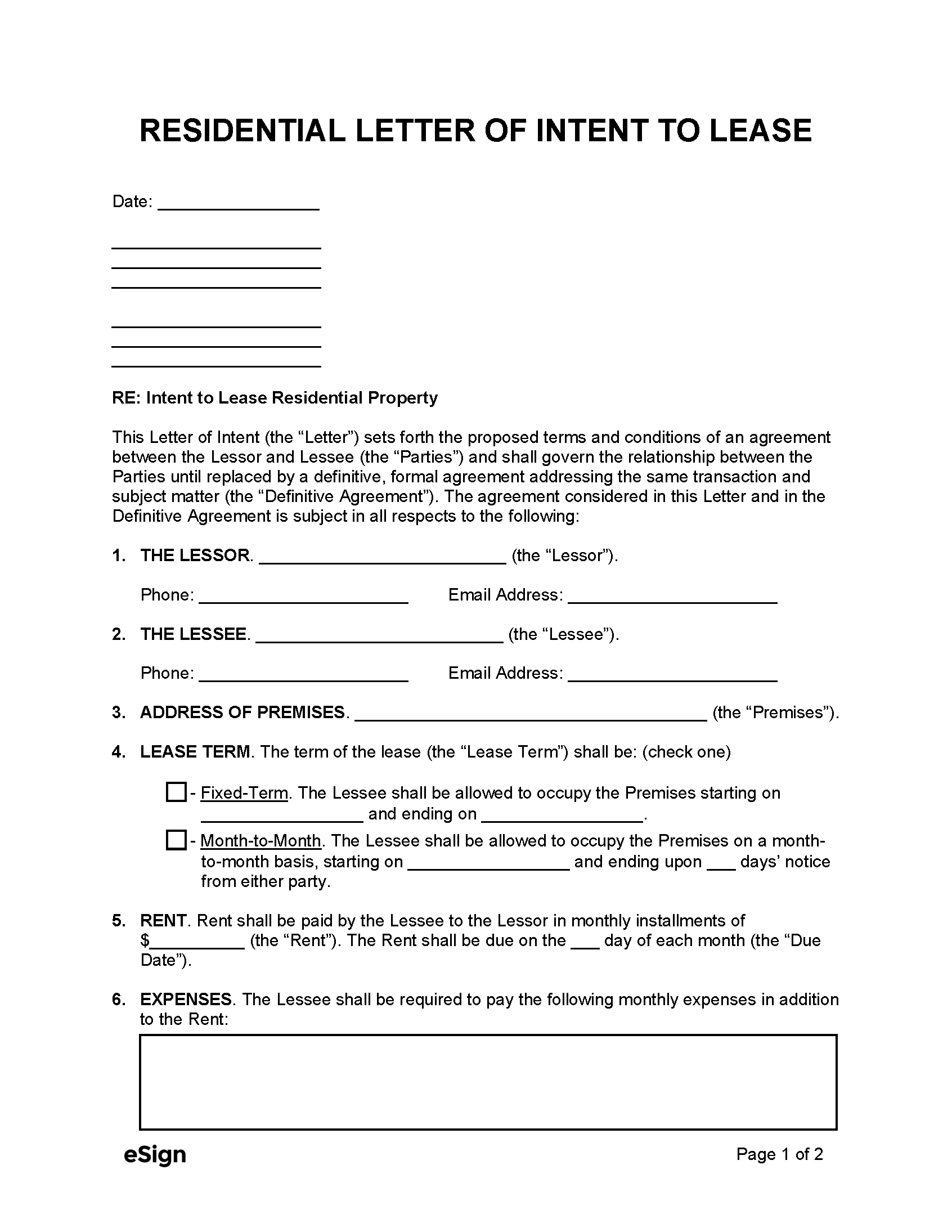Related Forms
- Residential Rental Application – Used to screen prospective tenants prior to signing a lease.
- Residential Lease Agreement – A comprehensive contract for renting property to residential tenants.
How to Write
- Date & Contact Info – The date and each party’s name, address, and contact info.
- Intention – A statement affirming the parties’ intent to sign a residential lease agreement.
- Property Address – The complete street address of the residential property being leased.
- Lease Term – The length of the proposed lease agreement.
- Monthly Rent – The proposed monthly rental amount and the due date for payment.
- Late Fees – Fees that the landlord can charge if rent isn’t paid on time.
- Security Deposit – The amount paid to cover potential property damage.
- Signatures – The signatures and printed names of the applicant and landlord.
Letter of Intent vs. Lease Agreement
A letter of intent is used during the early stages of a lease negotiation to outline basic terms and conditions for a residential tenancy, whereas a lease agreement is the definitive and legally binding rental contract between a landlord and tenant that establishes their rights and responsibilities.
Sample
Download: PDF, Word (.docx), OpenDocument
RESIDENTIAL LETTER OF INTENT TO LEASE
Date: [DATE]
[SENDER (e.g., LEASE APPLICANT) NAME]
[SENDER STREET ADDRESS]
[SENDER CITY, STATE, ZIP]
[RECIPIENT (e.g., LESSOR) NAME]
[RECIPIENT STREET ADDRESS]
[RECIPIENT CITY, STATE, ZIP]
RE: Intent to Lease Residential Property
This Letter of Intent (the “Letter”) sets forth the proposed terms and conditions of an agreement between the Lessor and Lessee (the “Parties”) and shall govern the relationship between the Parties until replaced by a definitive, formal agreement addressing the same transaction and subject matter (the “Definitive Agreement”). The agreement considered in this Letter and in the Definitive Agreement is subject in all respects to the following:
1. THE LESSOR.
[LESSOR NAME] (the “Lessor”).
Phone: [LESSOR PHONE]
Email Address: [LESSOR EMAIL]
2. THE LESSEE.
[LESSEE NAME] (the “Lessee”).
Phone: [LESSEE PHONE]
Email Address: [LESSEE EMAIL]
3. ADDRESS OF PREMISES. [PREMISES ADDRESS] (the “Premises”).
4. LEASE TERM. The term of the lease (the “Lease Term”) shall be [WRITE “fixed” OR “month-to-month”]. The Lessee shall be allowed to occupy the Premises starting on [LEASE START DATE] and ending on [LEASE END DATE].
Note: If the lease term is month-to-month, delete the text after “[LEASE START DATE]” above.
5. RENT. The rent to be paid by the Lessee to the Lessor throughout the Lease Term is to be made in monthly installments of $[RENT AMOUNT] (the “Rent”). The Rent shall be due on the [#] day of each month (the “Due Date”).
6. EXPENSES. The Lessee shall be required to pay the following monthly expenses in addition to the Rent: [LIST EXPENSES TO BE PAID BY LESSEE].
7. LATE FEE. If Rent is not paid by the Due Date, the Lessee shall be required to pay the following late fee: [DESCRIBE LATE FEE (IF ANY)].
8. DEPOSIT. The Parties agree that a security deposit [WRITE “will” OR “will not”] be required. If required, a security deposit in the amount of $[DEPOSIT AMOUNT] shall be paid by the Lessee to the Lessor prior to or upon the signing of a lease.
Note: If a security deposit will not be required, delete the sentence beginning with “If required” above.
9. FURNITURE AND APPLIANCES. The Lessor shall supply the following furniture and appliances on the Premises for the Lessee’s use: [LIST FURNITURE AND APPLIANCE PROVIDED BY LESSOR].
10. INTENTION OF THE PARTIES. This Letter sets forth the intentions of the Parties to use reasonable efforts to negotiate, in good faith, a Definitive Agreement with respect to all matters herein. Notwithstanding paragraphs 12 through 14, which shall be legally binding, any legal obligations with respect to all other matters shall only arise if and when the Parties execute and deliver a Definitive Agreement.
11. GOVERNING LAW. This Letter shall be governed under the laws of the State of [STATE NAME].
12. SIGNATURES.
Lessor’s Signature: ___________________ Date: [MM/DD/YYYY]
Print Name: [LESSOR NAME]
Lessee’s Signature: ___________________ Date: [MM/DD/YYYY]
Print Name: [LESSEE NAME]

